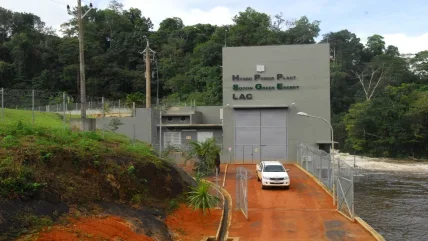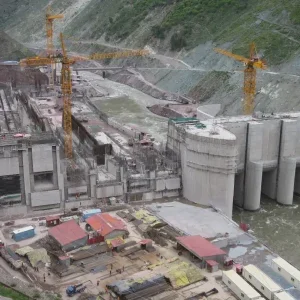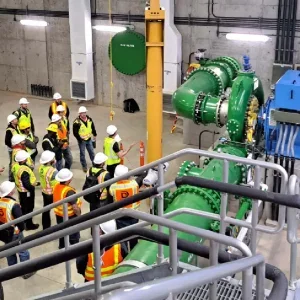
The Godavari River basin (GRB) is India’s largest peninsular river basin, covering approximately 9.5% of the country’s geographical area, equivalent to 312,812km2. Characterised by a tropical climate, it largely depends on summer monsoon rainfall which contributes to approximately 85% of its annual precipitation, and as it predominantly consists of clay and sandy loam clay soils, it also has low infiltration rates and high runoff.
There are more than 15 major pieces of water infrastructure such as dams and reservoirs that have been specifically designed to support irrigation, water supply, and hydropower generation along the GRB. These have a combined storage capacity exceeding 21 billion m3 with an installed hydropower capacity exceeding 2.7 GW, and a total irrigated area of around 6000km2. However, with future climate projections indicating an increase in the frequency of droughts from 2053 to 2099, with the impacts of climate change and El Nino expected to exacerbate the seasonality and significantly reduce water availability in the basin, there are growing concerns regarding the vulnerability of hydropower generation and energy security during such periods.
To mitigate the vulnerability of hydropower generation induced by El Nino events and enhance preparedness, a new report published in the Journal of Hydrology, says it is imperative to construct new run-of-river small hydro plants and storage hydro projects as part of an adaptation strategy to increase basin resilience.
The study, called “Mitigating El Nino impacts on hydro energy vulnerability through identifying resilient run-of-river small hydropower sites” by Thakur et al, addresses the potential for small hydropower generation in the Godavari River Basin, assess the specific impacts of El Nino on such proposed run-of-river developments here, and tries to determine if these can maintain firm power even during El Nino years.
The analysis identified 226 potential sites within the GRB based on the head along the river, with a combined power and annual energy generation estimate of 92MW and 0.4 TWh/yr, respectively, at 90% flow dependability. The authors say that after meticulous screening, 11 potential sites based on the head and the power potential demonstrated a decline of 46.03%, 37.97%, and 17.77% in annual energy at 30%, 75%, and 90% flow dependability, respectively, leaving nine sites maintaining the firm power (90% flow dependability) even during El Nino years.
“Our findings underscore the increased risk of power shortages during El Nino years and emphasise the need to develop appropriate strategies to cope with the risks associated with El Nino events,” the authors commented.
“Although our integrated approach has significantly enhanced the credibility and accuracy of our findings, furnishing decision-makers and stakeholders with valuable insights for energy planning and policy development in the GRB region, further investigations into their environmental, social and economic feasibility are crucial to ensure responsible implementation,” Thakur et al continued. “While the proposed modelling framework is demonstrated here for the GRB in India, it exhibits strong potential for extension to other basins. This scalability could effectively address the growing energy demand from renewable sources like SHP in the context of mitigating the impacts of climate change.”
On the Nile
Another study has also proposed a new strategy for using small hydroelectric turbines in downstream branches of the Nile River in Egypt. Published in Scientific Reports, the authors experimentally evaluate the reading of velocity profiles that were collected in one of the most famous branches of the Nile River (the Menoufia Branch) just after the barrage. The study suggests that the available high flow rates and high pressure values can produce up to 0.75MW from a single station with the least amount of construction and the lowest cost.
According to the nature of the waterway, Mohamed E.A.E. Ahmed et al say that the best diameter of a turbine that can be used is 1.5m based on water velocities and river depths. The proposed power plant generated 25.8kW per single turbine row, with an estimated cost of produced power (0.035 USD/kWh) of approximately 20 turbines installed per row. Compared to other renewable energy sources, the proposed hydropower system is cost-effective and environmentally friendly, as generating electricity with the proposed small hydropower plant could reduce annual carbon dioxide emissions by 368 tonnes of CO2 per single turbine row.
Mexico
Small hydropower projects have emerged as a promising contribution set to play a vital role in Mexico’s renewable energy landscape. Research by Veronica Luis and Kathy Davis in the International Journal of Hydropower and Civil Engineering, has recently scrutinised the hydraulic implications and environmental repercussions of small hydro in the Mexican context (categorised as 10MW and below), delving into an assessment of their effects on watercourses, aquatic ecosystems, and local communities.
In conclusion, the authors say that the development of small hydro in Mexico “signifies a pivotal stride towards sustainable energy generation, aligning with the nation’s renewable energy goals”. In addition such projects, “characterised by lower environmental footprints and decentralised power generation, offer promising solutions for rural electrification and economic development”.
However, the authors add, challenges do persist, including regulatory compliance, community engagement, and the need for continual improvements in operational efficiency.
“Balancing energy needs with environmental preservation remains paramount, necessitating ongoing monitoring and adaptive strategies. Embracing small hydro signifies Mexico’s commitment to fostering renewable energy sources,” they conclude, “while navigating the complexities of energy development in harmony with environmental stewardship and social welfare.”
Hydro at QEII Docks
Peel Ports Group, one of the UK’s major port operators, has revealed plans to implement hydropower technology at its Queen Elizabeth II Dock in Eastham in England. Teaming up with Czech renewable energy firm Hydropol, Peel Ports will install a modern twin Archimedean screw generator at the dock’s lock. Expected to generate approximately 1.5GWh per year, this is equivalent to powering around 190,000 homes for a day, and Peel Ports will acquire the renewable energy from Hydropol through a unique private energy procurement arrangement. The generated power will not only supply the dock itself but also fuel the operations of Peel ports’ Green Automotive Hub, established in late 2023 to support eco-friendly vehicle manufacturing.
“The introduction of hydropower at Queen Elizabeth II Dock is another major achievement as we seek to make our operations greener and more sustainable for the future,” commented Lewis McIntyre, Managing Director of Port Services at Peel Ports Group. “The amount of renewable energy set to be produced is significant and builds on Eastham Dock’s sustainable credentials.”
Scottish Water
Scottish Water has broken ground on a pioneering new type of hydro energy generation scheme at Whiteadder Reservoir in East Lothian. Believed to be the first of its type in Europe, the project will be fed by a siphon, enabling the company to generate green energy while accurately controlling reservoir levels during seasonal fluctuations in weather, without the need for major civil engineering works.
This £3 million scheme, being delivered by renewable energy specialist Emtec Energy, will enable the siphon technology to draw water up though the intake and over the top of the dam which then runs down through the siphon, through the hydro turbine, and back to the natural environment. It is expected that 0.82GWh of renewable energy will be generated from the 199kW turbine each year, which will be used to offset 30% of the power used by one of East Lothian’s largest pumping stations, named Hungry Snout. This pumping station takes around 32 million litres of water per day to Castle Moffat Water Treatment Works, which supplies most of the East Lothian region.
“This is a unique project to work on,” says Neil Beaumont, Hydro Energy Senior Project Manager at Scottish Water Horizons, the public utility’s commercial subsidiary that is delivering the scheme. “Due to fluctuating seasonal conditions in Scotland, the flows at Whiteadder Reservoir vary from 150-1200 litres per second so it was important that we could measure and control the reservoir levels accurately as its primary function is to provide water to customers.
“In collaboration with renewable energy experts AECOM and Ossberger, we selected equipment that could accurately measure water levels even during adverse weather conditions using smart controls and sensors which will ensure we are not taking too much water from the reservoir. This is a real win for us,” he added, “and we are delighted to be leading with such innovative projects to lower the carbon footprint of the local water supply and make Scotland’s grid greener.”
As Gordon Reid, Scottish Water’s General Manager for Net Zero, added: “Scottish Water owns the most reservoirs in the UK, and we are always looking for opportunities to produce renewable power and make the most of these assets. We already have over thirty hydro turbines installed on our assets, and the use of this novel technology is an exciting development for Scottish Water.”
Nigerian projects
The European Union has introduced two new projects in Nigeria: the Small Hydro Power Development for Agro-industry Use in Nigeria (SHP-DAIN) and Advancing Nigeria’s Green Transition to Net Zero through Circular Economy Practices. Both will be undertaken by the United Nations Industrial Organisation (UNIDO) as part of a three-year contract, aimed at promoting small hydropower development and circular economy approaches.
Adenayo Adelabo, Nigerian Minister of Power, acknowledged the support of UNIDO and the EU by saying: “Nigeria’s abundant energy resources will forever remain potentials unless properly harnessed, therefore, the federal ministry of power is delighted to continually work with the EU and UNIDO on small hydropower in powering energy through decentralised systems.”
The projects aim to enhance energy accessibility and promote circular economy practices to address pollution and climate change in Nigeria. SHP-DAIN aims to boost small hydropower capacity in the energy mix, increase agricultural productivity, and improve livelihoods, thereby enhancing food security and job opportunities. While Advancing Nigeria’s Green Transition to Net Zero through Circular Economy Practices aims to enhance the management of used off-grid energy equipment and plastics through circular economy practices to mitigate pollution and greenhouse gas emissions.
This article first appeared in International Water Power magazine.






